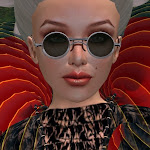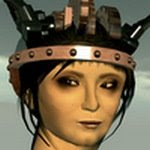In the garden of Jung's country home in Bollingen stands a large cube-shaped stone inscribed by his own hand with magical and alchemical symbols. In his last revelatory dream prior to his death, Jung saw a huge round stone engraved with the words "And this shall be a sign unto you of Wholeness and Oneness". - THE GNOSIS ARCHIVE by Stephan A. Hoeller
British virtual landscape artist soror Nishi believes that the prim, that basic building tool in Second Life, is akin to prima materia (primal matter), a term used by alchemists to describe the seed of life. Prima materia was originally called Microcosmos to signify the small world from which heaven, earth, fire, water, and all manifestations of life are derived, including birth, death, creation, and even the resurrection. With this in mind, what could be more deserving of a temple, worship, and even a religion in Second Life than the crown of virtual creation... the plywood prim? To that end, she has created a temple and forest to that divine source of life and death: The Temple of the Prim.
The Temple of the Prim as photographed by Lem Skall
On her blog, soror discusses the term Increatum, wherein she describes prima materia as "fertilizing and giving birth to itself," and goes on to draw parallels between it and the basic prim.
Last Friday in conversation, soror explained: “This has been on my mind for well over a year. (The prim) makes itself and therefore is like a god. Gods need temples and the prim is self-replicating like the old gods. I think there's not really much in Prima Materia. It is just empty, but it reflects the psyche. According to Jung, when people speculate about the unknowable, they say more about their own psyche than they do about the unknowable, so the prim is a bit like a mirror."
soror's signature cracked-egg trees are made with prims, as is everything in Second Life
soror went on to say, "Jung was the first (only) person to take alchemy seriously as a description of the transformation of the individual from "normal" to enlightened. He saw a direct link between the "way you make gold from prima materia' and the process of "individuation" (his word). All the chemical processes that the alchemists describe are anthropomorphic, like Mercury is a person… kings and queens. It's all like a fairy story, with characters dying, etc. These relate to dreams: Archetypes (his word) and the land of dreams... is... (should be) SL...?”
"The Prim worship thingy is magic, and magic is what Synchronicity is (also a Jung word). Jung would LOVE SL," shared soror. 
Looking down into the Temple of the Prim
soror Nishi: "I came to Jung through my interest in geometry and the Axiom of Maria: One becomes two, two becomes three...etc. Maria was an old alchemist. Alchemists believed that whereas Christ had redeemed man, no one has redeemed matter, and they saw the search for the Philosophers Stone (the Self) to be an aim higher than Christianity. I got interested in geometry as a sort of universal truth. I was fascinated that it transcends language, in my teens that is."
Alchemists were challenged not only with the vagaries of their science, but also with the ongoing tribulations of securing funding for their incredibly expensive practice. These early scientists resorted to creating a narrative using anthropomorphic symbols to describe chemical reaction processes more impressively and make them comprehensible to the layperson. What they fabricated was nothing short of mythology, imbued with allegories, metaphors and archetypes steeped with rich personalities.
Hundreds of years later and in his early 30s, the founder of analytical psychology, Carl Jung, began working on a manuscript bound in red leather that would contain illustrations and calligraphy by his own hand. In this document – considered the Holy Grail of the Unconscious - he explored his theories on archetypes, collective unconscious (the mystery of the universally unknown), and individuation, or the process of transforming one’s psyche by bringing the personal and collective unconscious into conscious. Each of his archetypes represent an aspect of our deepest, and highest (or darkest), self.
At times, soror's landscaping is reminiscent of Asian paintings
Soror’s Temple of the Prim is also a tribute to Carl Jung, which is especially fitting given the publication this month of that manuscript that he worked on for 16 years. Locked in a bank vault all this time, the Red Book has only been seen by a few people.
Now the Ruben Museum in New York will be displaying the original book in conjunction with a series of events called the Red Book Dialogues, wherein “personalities from many different walks of life will be paired on stage with a psychoanalyst and invited to respond to and interpret a folio from Jung's Red Book as a starting point for a wide ranging conversation.” Those guests include musician and artist David Byrne, graphic designer Stefan Sagmeister, director John Boorman, and philosopher Cornel West.
The Temple of the Prim is on temporary display thanks to Mab MacMoragh's sponsorship and can be visited by teleporting directly from here.
See also:
Tuesday, October 6, 2009
The Temple of the Prim and a tribute to Carl Jung, who surely would have loved Second Life
Posted by
Bettina Tizzy
at
3:41 PM
![]()
Labels: alchemy, archetypes, Jung, landscape art, Mab MacMoragh, Prima Materia, Soror Nishi, Temple of the Prim











2 comments:
No-one could hope to have a more insightful piece written about their work than this. I haven't/couldn't express myself so lucidly, thanks Bettina.
Lem has, (again) shown me images of my work which I haven't seen.
I do think that Jung is the most underrated genius; so great that you included this piece about the book.
Beautiful work Soror. Thank you for having me DJ the grand opening
Post a Comment